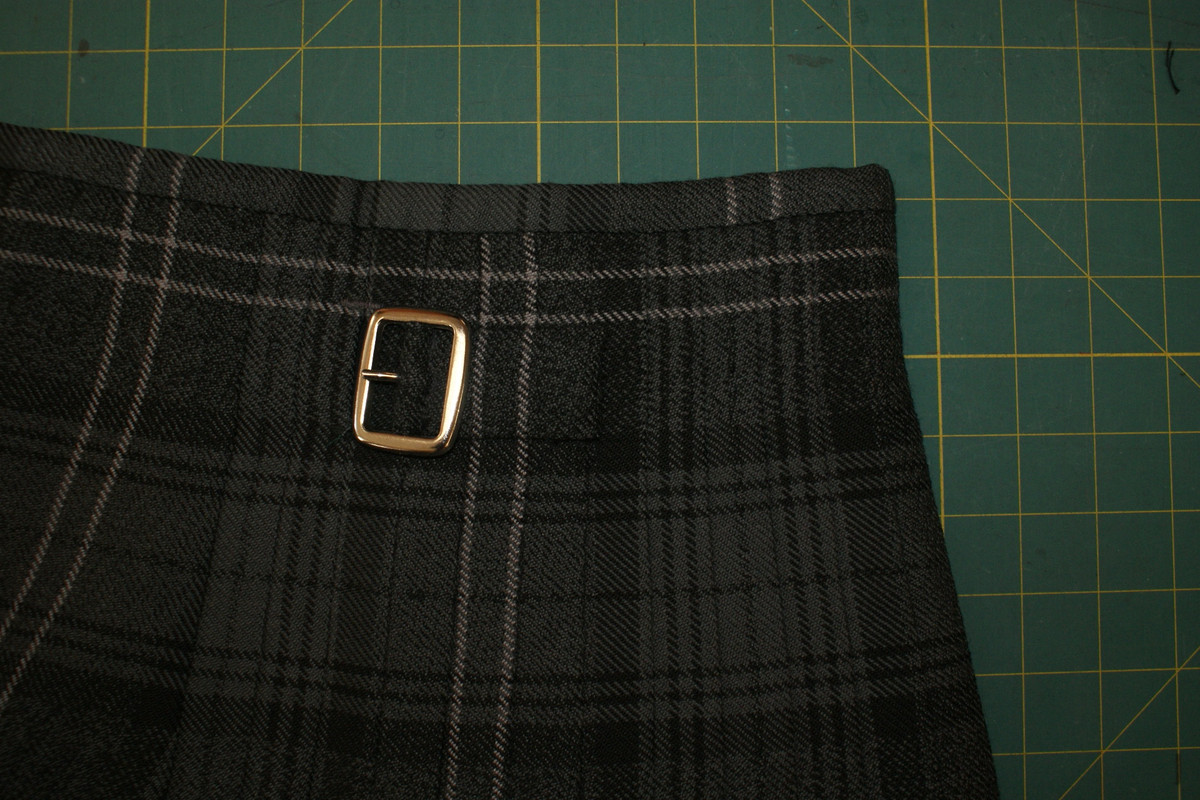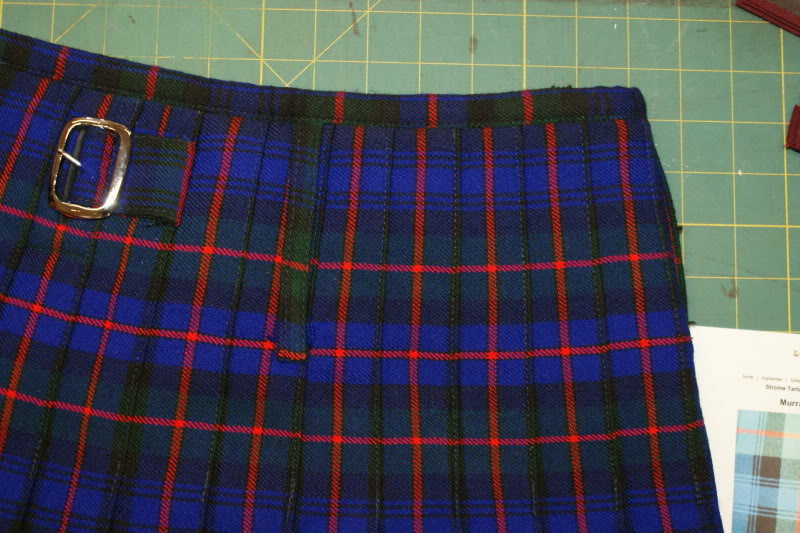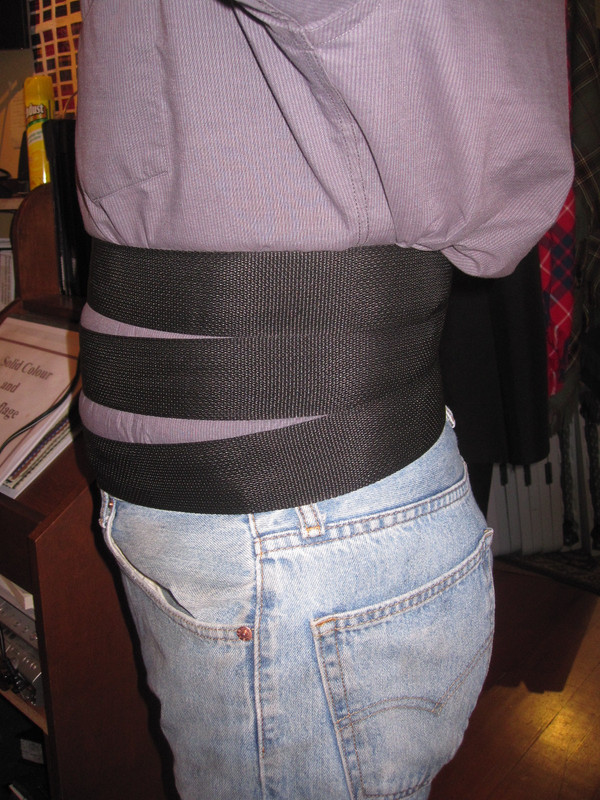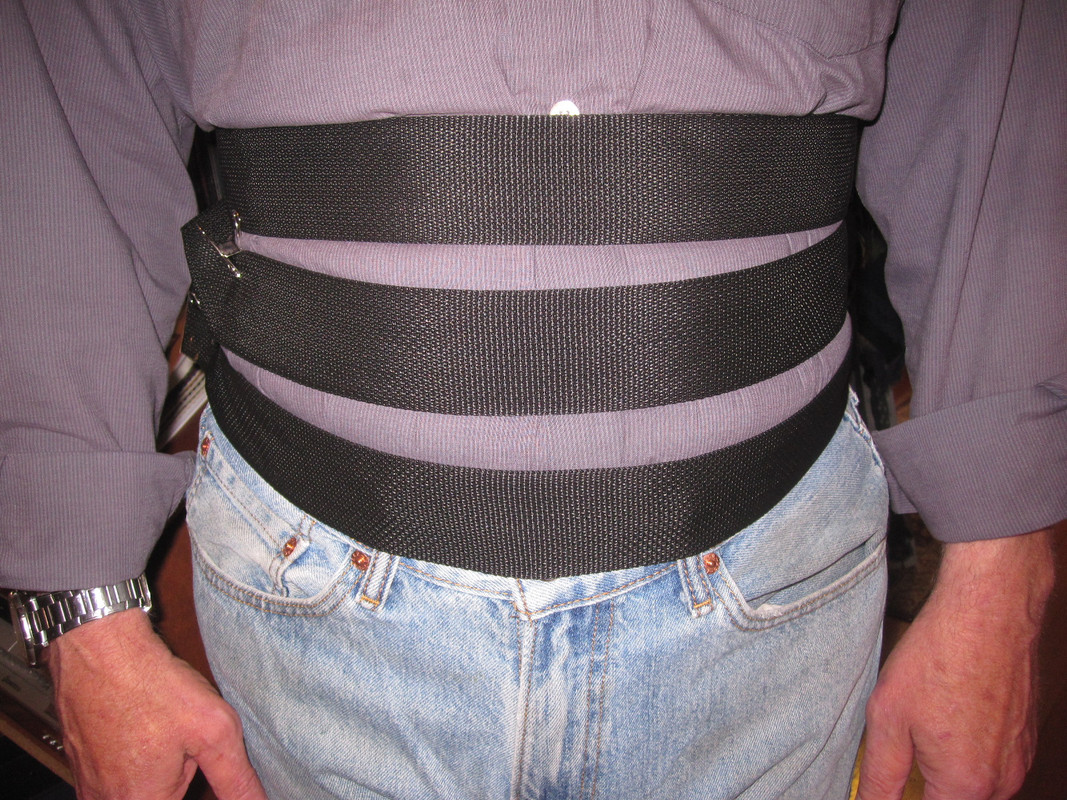|
-
21st February 20, 06:17 PM
#21
This is what Barb means when she says the kilt will have flare above the top strap.

Versus a kilt like this without flare.

In the top photo the smallest part of the kilt is at the level of the top strap. This kilt will cinch into the smallest part of the body and not move.
In the lower photo the top of the kilt is the smallest part and no matter how tight you cinch the straps the kilt will drop down until the smallest part of the kilt is at the smallest part of your body.
-
The Following 2 Users say 'Aye' to Steve Ashton For This Useful Post:
-
21st February 20, 06:24 PM
#22
And one quick way of telling if the kilt is the right size is to measure the circumference of your body at the anatomical waist, and them again down at the widest part of your hips and butt.
When measuring your hips please remember that you do not pull the tape measure in at the front. You pull the tape outward just a bit to simulate the apron falling straight down from the front of the belly.
Then - The apron should be, at a minimum, 1/2 of the waist circumference. A little more than 1/2 is better.
And the rear of the kilt or pleated part at the hips - or where the bottom of the pleats are sewn down - should be, at a minimum 1/2 the hip circumference. A little more is better.
And the total of the apron at the waist + the pleated part, at the waist, should equal or be slightly more than the waist circumference.
And the total of the apron at the hips + the pleated part at the hips, should equal or be slightly more than the the hip circumference.
-
The Following 2 Users say 'Aye' to Steve Ashton For This Useful Post:
-
21st February 20, 07:16 PM
#23

 Originally Posted by Steve Ashton

The apron should be, at a minimum, 1/2 of the waist circumference. A little more than 1/2 is better.
And the rear of the kilt or pleated part at the hips - or where the bottom of the pleats are sewn down - should be, at a minimum 1/2 the hip circumference. A little more is better.
And the total of the apron at the waist + the pleated part, at the waist, should equal or be slightly more than the waist circumference.
And the total of the apron at the hips + the pleated part at the hips, should equal or be slightly more than the the hip circumference.
Thank you so much!
Anatomical waist: 30" (pulled tight)
Seat: 36" (pulled tight w/o kilt); 38" (loose over kilt)
Front apron: 15.5" (at top band from seam to edge before fringe); 16" (at top strap height); 16.9" (at bottom of fell)
Inner apron: 16" (at top band from seam to edge); 16.5" (at top strap height); 17.5" (at bottom of fell)
Rear: 15.3" (at top band from seam to seam); 17" (at buckle height); 20.5" (at bottom of fell from seam to seam)
Kilt circumference
At top band: 30.8"
At buckle height: 33"
At bottom of fell: 37.4"
Measuring from the buckle to the first hole of the inner apron strap is 30.5"
 Originally Posted by Barb T

In your photo below, it's the top edge of the kilt, not the buckle line, that looks to me like it's in the small of your back...
The buckle looks like its lower and riding on the slope of your side below your waist...
If the pleats and the apron edges taper all the way to the top of the kilt, your kilt will inevitably slip down until the top edge of the kilt (the smallest dimension) sits at the smallest part of your circumference, which coincides with the small of your back even if you buckle the kilt tightly. Having flare prevents that from happening - with flare, the top stays high (and comfortable) and the buckle line stays put in the small of your back when the kilt is buckled tightly.
I really appreciate you persevering in helping me, and I don't mean to question your expert eye, but the thing is that I can press on the straps and feel that they are nestled between my ribs and top of my pelvis. The top band is about 2 inches above my navel and over the ribs. I'm happy to post photos without a shirt on if that helps you determine where it is actually sitting, but I don't want to offend you or anyone else with my bare midriff.
Last edited by Dreaghann; 21st February 20 at 09:12 PM.
-
-
21st February 20, 08:09 PM
#24
OK, about the anatomical waist.
It is not half way between the bottom of the ribs and the pelvis. It is right up under the ribs at the side. Above the short ribs in back. And about 3-4 finger widths below the bottom of the rib cage in the front.
Here is a photo which may help.
The top strap is right under the ribs.
The middle strap is right on top of the hip bones.
And the lower strap is where blue jeans are worn, below the top of the hip bones.

From the front this shows that the top strap is actually at the smallest part of the body. And quite a way higher than the hip bones.

One easy way to find the anatomical waist is to put a finger just under your ribs at the side. Then bend toward your finger. You should be able to feel a hole at your finger. This is your anatomical waist. What we call waist today is a fashion thing and subject to change of fashion.
And soft tissue moves. This is why we say never go by the navel. One guys navel may be a totally different place than another guy.
So we use the bones which do not move. And where your spine bends in the torso is the anatomical waist.
-
The Following 2 Users say 'Aye' to Steve Ashton For This Useful Post:
-
21st February 20, 09:11 PM
#25

Thank you for sharing that explanation. I have seen it before in other threads, and it was quite helpful to me at the time that I was trying to determine where to measure my waist size.
There's about 2" of vertical distance between the top of my pelvis (i.e., ilium crest) and my ribcage. The kilt straps are more than 1" wide. That means there's less than an inch to move up or down before the straps are either over the ribcage or over the ilium crest. In the last set of photos I cinched them in just below my ribs and above the the ilium crest (not over or around the ilium crest). Are you wanting me to cinch the straps over my ribcage?
Last edited by Dreaghann; 25th February 20 at 01:24 PM.
Reason: Added links to photos
-
-
21st February 20, 09:29 PM
#26
It is very possible that one of the problems with the fit of this kilt is that there may not be any flare above the top straps.
Can you fold the kilt in half and look at the pleats where it is folded.
Does the kilt flare outward above the top strap with the center of the strap being the smallest part?
Or does the kilt continue above the top strap in a straight line with the smallest part at the top band?
-
The Following 2 Users say 'Aye' to Steve Ashton For This Useful Post:
-
21st February 20, 10:33 PM
#27
There is definitely no flare in the rise above the straps. The narrowest part is at the top band of the kilt, not at the straps. The measurements I posted earlier bear this out as well.
It seems to me that the apron is too narrow and this results in it pulling away at the bottom of the fell and then kicking out at bottom.
The kilt maker doesn't seem to have taken into consideration the way in which the vendor's posted kilt measurement instructions for a "traditional kilt" are written: "tightly around waist at the navel" and "from the line used for the waist measurement to mid-knee, or top of knee." Since the straps should be at the waist for a traditional kilt, they should have added 2 inches to the total length. If they had intended the top band to be worn at the waist instead, the fell should have been shortened 2 inches instead and the bottom buckle moved up. In addition, the instructions made no mention of measuring loosely around the seat which probably contributes to the apron pulling away.
Thank you for all your help in getting to the bottom (pun intended) of this issue.
Last edited by Dreaghann; 22nd February 20 at 01:54 PM.
Reason: Edited for clarity
-
-
22nd February 20, 07:57 AM
#28
 Originally Posted by tylerkinkade

There is definitely no flare in the rise above the straps. The narrowest part is at the top band of the kilt, not at the straps. The measurements I posted earlier bear this out as well.
I wrote several things on page 2 of this thread about flare, and it's clear from both your measurements and your photos (I posted zoom-ins on page 2) that your kilt has no flare above the buckle line. How much does a kilt need to flare? Here's an example. My waist is 27 1/2". If I measure 2" above that, where the top of my band kilt sits, my circumference (which is around my lower rib cage) is about 28 1/2"". If my kilt didn't flare an inch from the buckle line to the top, I wouldn't be able to buckle it tightly at the waist, because it would dig into my rib cage. And, if I couldn't buckle it tightly, it would just sag down until the top edge was at my waist. That's the issue with your kilt. I once made a kilt in regimental weight tartan for a knife-maker who wanted to wear the kilt in his forge and asked for a 3" rise. I had to flare the kilt several inches above the buckle line so that it would sit properly and feel comfortable.
I am consistently amazed by how many kiltmakers don't understand the need for flare above the buckle line. Maybe it's because they've never worn a kilt themselves and don't understand the function, or maybe they've never really analyzed the anatomical factor behind the need for a rise. I recently rebuilt a kilt for a person who purchased a custom-made kilt from a fairly well-known kiltmaker. The kilt was tapered all the way to the top in both the pleats and along the apron/underapron edges. I took off the lining and top band, unstitched the top parts of the apron and underapron edges and restitched them straight, and I just stretched the top edge of the kilt above the stabilizer. There was enough flex above the stabilizer that I could get the extra length I needed even without changing the pleats. I stitched the top band back on, and the kilt now had enough flare to stay put when buckled at the waist.
It seems to me that the apron is too narrow and this results in it pulling away at the bottom of the fell and then kicking out at bottom.
When I ask people to measure for a kilt, I ask for a snug (but definitely not tight) measurement over a shirt for the waist, and a loose measurement over a pair of jeans for the hips. I would never, ever measure the hips tight over underwear. If someone has a belly, I use the towel method to fill the space under the belly, and I measure the hips around that.
I think that it's not the width of the apron that contributes to the first pleat kicking forward but, rather, the fact that the hip measurement is too small. It's not the only factor, but it contributes to the apron pull at the hips.
I do agree that the proportions at the hips seem really off to me. You have measured the apron at the hips as ~17" and the pleats in the hips at 19.5". Unless someone has a huge waist/hip differential (more than 11 or 12"), I would never put more than an inch more in the pleats than in the apron at the hips - kilts should look like they have roughly half pleats and half apron. Because the buttocks stick out in the back and the small of the back curves in, I put an inch more in the pleats at the hips than I put in the apron and an inch less in the pleats (commonly an inch and a half or even two, depending on waist/hip differential) at the waist than I put in the apron. This makes the apron/pleats boundary hang nice and vertical when viewed from the side and gives the illusion of a half-and-half split. But 2 1/2" difference in the hips? That puts too much in the pleats and not enough in the apron. That can contribute to "the wave" across the pleats at the bottom of the fell.
The kilt maker doesn't seem to have taken into consideration the way in which the traditional kilt measurement instructions are written: "tightly around waist at the navel" and "from the line used for the waist measurement to mid-knee, or top of knee." Since the straps should be at the waist for a traditional kilt, they should have added 2 inches to the total length. If they had intended the top band to be worn at the waist instead, the fell should have been shortened 2 inches instead and the bottom buckle moved up. In addition, the instructions made no mention of measuring loosely around the seat which probably contributes to the apron pulling away.
First, there isn't a traditional way that measurement instructions are written. Different kiltmakers give different instructions. I assume you followed your kiltmaker's instructions, but, just for the record, it's absolutely critical to take measurements exactly as the kiltmaker instructs.
Second, if the kiltmaker had intended the top of the kilt to be worn at the waist, he/she wouldn't have added a rise (unless this kiltmaker actually doesn't know what a rise is...), and the buckles would have been as close to the top band as possible. So, I think it's virtually certain that your kiltmaker deliberately added a rise. The issue is that he/she didn't know how to shape the rise properly, I'm sorry to say.
Last edited by Barb T; 22nd February 20 at 08:29 AM.
-
The Following 3 Users say 'Aye' to Barb T For This Useful Post:
-
22nd February 20, 02:31 PM
#29
 Originally Posted by Barb T

I do agree that the proportions at the hips seem really off to me...
...First, there isn't a traditional way that measurement instructions are written. Different kiltmakers give different instructions. I assume you followed your kiltmaker's instructions, but, just for the record, it's absolutely critical to take measurements exactly as the kiltmaker instructs.
Second, if the kiltmaker had intended the top of the kilt to be worn at the waist, he/she wouldn't have added a rise (unless this kiltmaker actually doesn't know what a rise is...), and the buckles would have been as close to the top band as possible. So, I think it's virtually certain that your kiltmaker deliberately added a rise. The issue is that he/she didn't know how to shape the rise properly, I'm sorry to say.
Thank you so much for sharing your expertise! Your explanation makes perfect sense to me.
I'm afraid my comment about the instructions was not written clearly. I meant to say that the vendor's instructions for what they market as a "traditional kilt" were not reflected in the kilt's actual design. I also meant that, although the actual kilt includes a 2" rise, the measurement instructions do not account for that and actually describe the drop length. Therefore the kiltmaker should have (but did not) add 2" to the length submitted by the customer. The instructions said to measure "tightly around waist at the navel," "around the widest part of the buttocks," and "from the line used for the waist measurement to mid-knee, or top of knee." I followed these to the letter and ended up with a 2-inches too-short kilt with a fell designed to be worn with the top straps at the waist, but which cannot be sustainably worn at that height due to the lack of flare in the rise, with incorrect splits at the hips, and an inexplicable kick out at the bottom of the apron.
The hard lesson I have learned is to ask more questions before clicking "buy."
I have contacted clan.com about these issues and hopefully they will provide a reasonable solution.
Thank you all again for your help with this. I have learned a lot, including the true value of expert kiltmaking, and will hopefully be wiser in the future.
Last edited by Dreaghann; 22nd February 20 at 02:42 PM.
-
-
23rd February 20, 04:48 AM
#30
 Originally Posted by tylerkinkade

The left pleat of my brand new Balmoral traditional 8-yard Scotweb/Clan.com 13 oz wool kilt's front apron does not lay flat (i.e., it sticks out):
Attachment 38177
Attachment 38178
Robert MacDonald talks about this issue at 2:16 of his video and explains why he always waits to iron this pleat until he has the customer try it on for the first time (which obviously wasn't possible in my case):
https://youtu.be/Ivv8hwr0TZE?t=136
Is it possible to fix this by resetting the pleat with a steam iron? How would I go about doing that? Do I need to remove the original pleat first? If so, how?
It could be that the measurements are a bit off but by the looks of the photo its a kicking pleat, it means the kiltmaker has not put the fold of the first pleat high enough into the waistband. There's a simple fix if you want pm me.
Nikki
-
The Following User Says 'Aye' to Kiltmakers Laird For This Useful Post:
Tags for this Thread
 Posting Permissions
Posting Permissions
- You may not post new threads
- You may not post replies
- You may not post attachments
- You may not edit your posts
-
Forum Rules
|
|
























Bookmarks